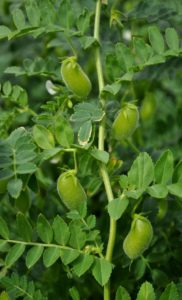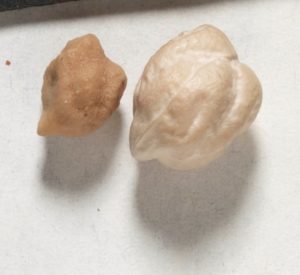Chickpeas
What are chickpeas?
Chickpeas are a pulse crop that is part of the legume family. The word “pulse” comes from the Latin word puls, meaning potage or thick soup. Pulses are the dry edible seeds of pod plants and are high in protein and fibre and low in fat.
The common cultivated chickpea is botanically classified as Cicer arietinum L. Within Cicer arietinum there are two major seed types that are grown in Alberta: Desi and Kabuli. Desi-type are small and produce coloured flowers, whereas Kabuli are large and produce white flowers. The majority of chickpeas grown in Alberta are the Kabuli type.

Figure 1: Field of Chickpeas, Kabuli type
Where do chickpeas grow?
Chickpeas are a relatively small pulse crop in Alberta compared to field peas, and are grown across the southeastern part of the province.
In 2019, the majority of Alberta’s dry peas and chickpeas were exported to China and Bangladesh, with the remainder exported to India, Cuba, United States, Nepal, Colombia, Pakistan, Taiwan, Philippines, and other countries. The statistics for chickpeas are not separated out from dry peas so there may be some variation. In 2019, Alberta’s pulse growers grew 27,000 metric tonnes of chickpeas on 59,000 acres for a total farm cash receipts of $8.5 Million. The total value of chickpea exports was $14.8 Million.
(Source: Alberta Agriculture and Forestry, Economics and Competitiveness Branch)
Consider growing chickpeas if…
- You live in southeast Alberta with 110 to 120 frost-free days.
- You live in an area with high day and night-time temperatures.
- Your soil is medium-textured and loamy.
- Your fields have good drainage and low salinity.
- Your soil has a neutral to slightly alkaline pH of 7.0 to 8.0.
- You have high soil moisture and good pre-season soil moisture reserves.
- You’re interested in marketing flexibility that includes markets for both human consumption (including fractionation) and animal feed.
- You want to reduce your input costs (as pulses are nitrogen fixing); break disease cycles in your field; obtain a second-year yield boost in other crops following a pulse crop; improve your soil health; promote soil conservation and sustainable farming practices; and improve farm profitability.

Description

Chickpea is a short annual herbaceous plant, 30 to 70 cm tall. Some taller genotypes may exceed up to one metre under favourable conditions.
The main stem gives rise to a variable number (up to seven) of primary branches near ground level.
Depending on the angle of branches to the vertical main stem, growth habit ranges from near prostrate to erect – the primary branches and main stem produce a potentially large number of alternate secondary branches, with higher order branching rarely produced.
Foliage is similar to vetches with small subdivided leaves from 4 to 7 cm long, with 10 to 15 leaflets. Vetches are a large, central and dominant root from which other roots sprout laterally.
Chickpea has an extensive root system – the taproot often penetrates well below one metre.
The fruit is an inflated pod containing between two and four ovules.
Kabuli and Desi Chickpea Seed

Chickpea seed (depending on type) weighs from 200 to 500 gm per 1,000 seeds – Kabuli (garbanzo) seeds are
much larger than Desi seeds. Although seeds always possess the distinctive chickpea “beak” (radicle tip), they vary considerably in shape and colour:
-
- Kabuli types have larger, more rounded cream-coloured seeds (their creamy white colour is associated with the absence of anthocyanin pigmentation in the foliage).
- Desi types have relatively small, angular seeds with rough, usually yellow to brown seed coat.
Adaptation Characteristics
Optimal Temperature |
|
Spring Frost & Drought Tolerance |
|
Type |
|
Varieties |
|
Maturity/Dates |
|
Soil |
|
Stages of Development
The life cycle of the chickpea plant has four principal stages:
- germination and emergence
- vegetative stage
- reproductive stage
- senescence (mature stage)
Resources
History

Chickpea originated in southeast Turkey about 8,000 years ago with evidence indicating Cicer reticulatum L. as the wild ancestor. The cultivated chickpea is Cicer arietinum L. with two seed types Desi (small), and Kabuli (large) seed type. The Kabuli chickpea is thought to have evolved from a Desi type, probably by mutation.
From its origin in Turkey and Greece, the chickpea was soon spread by traders to Europe, North Africa, and India. Kabuli types reached India in the 18th Century. In the 16th Century, the Spanish and Portuguese had taken Kabulis with them to South and Central America. Chickpeas are believed to have been grown in the hanging gardens of Babylon, one of the Seven Wonders of the Ancient World. It took to the 1920s before chickpeas were commercially introduced in Canada, and the 1930s in California.
Although the wild species are difficult to maintain and have not been studied thoroughly, some of the wild species demonstrate attributes that may be useful for genetic improvement of Cicer arietinum (improved resistance to fusarium wilt, ascochyta blight, and botrytis grey mould). Although crosses between the wild and cultivated species are not generally successful, Cicer reticulatum can be readily crossed with Cicer arietinum to form hybrids that exhibit only slightly reduced pollen fertility and seed set.
Special thanks to Saskatchewan Pulse Growers.
